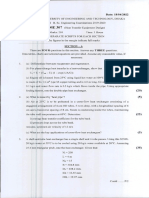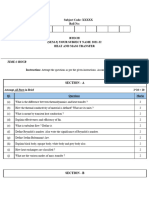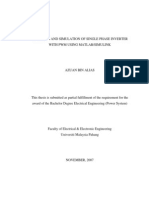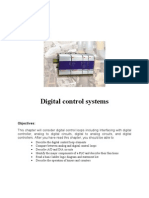100%(1)100% found this document useful (1 vote)
1K viewsCFD Exam Paper
CFD Exam Paper
Uploaded by
Abhishek AwasthiThis document is the exam for a Computational Fluid Dynamics course consisting of two parts with multiple choice and numerical questions. Part A contains 5 short answer questions about fluid dynamics formulations, discretization approaches, implicit vs explicit methods, the Peclet number, and staggered grids. Part B contains 5 longer answer questions about deriving momentum equations, partial differential equation classifications, the finite volume method, transformed domains, explicit/implicit heat equations, and discretization schemes.
Copyright:
© All Rights Reserved
Available Formats
Download as PDF, TXT or read online from Scribd
CFD Exam Paper
CFD Exam Paper
Uploaded by
Abhishek Awasthi100%(1)100% found this document useful (1 vote)
1K views2 pagesThis document is the exam for a Computational Fluid Dynamics course consisting of two parts with multiple choice and numerical questions. Part A contains 5 short answer questions about fluid dynamics formulations, discretization approaches, implicit vs explicit methods, the Peclet number, and staggered grids. Part B contains 5 longer answer questions about deriving momentum equations, partial differential equation classifications, the finite volume method, transformed domains, explicit/implicit heat equations, and discretization schemes.
Original Description:
Exam Paper Vit University
Copyright
© © All Rights Reserved
Available Formats
PDF, TXT or read online from Scribd
Share this document
Did you find this document useful?
Is this content inappropriate?
This document is the exam for a Computational Fluid Dynamics course consisting of two parts with multiple choice and numerical questions. Part A contains 5 short answer questions about fluid dynamics formulations, discretization approaches, implicit vs explicit methods, the Peclet number, and staggered grids. Part B contains 5 longer answer questions about deriving momentum equations, partial differential equation classifications, the finite volume method, transformed domains, explicit/implicit heat equations, and discretization schemes.
Copyright:
© All Rights Reserved
Available Formats
Download as PDF, TXT or read online from Scribd
Download as pdf or txt
100%(1)100% found this document useful (1 vote)
1K views2 pagesCFD Exam Paper
CFD Exam Paper
Uploaded by
Abhishek AwasthiThis document is the exam for a Computational Fluid Dynamics course consisting of two parts with multiple choice and numerical questions. Part A contains 5 short answer questions about fluid dynamics formulations, discretization approaches, implicit vs explicit methods, the Peclet number, and staggered grids. Part B contains 5 longer answer questions about deriving momentum equations, partial differential equation classifications, the finite volume method, transformed domains, explicit/implicit heat equations, and discretization schemes.
Copyright:
© All Rights Reserved
Available Formats
Download as PDF, TXT or read online from Scribd
Download as pdf or txt
You are on page 1of 2
Page 1 of 2
Term End Examination - November 2012
Course : MEE405 - Computational Fluid Dynamics
Slot: D1
Class NBR :
4835
Time : Three Hours
Max.Marks:100
(Symbols and Notations have their usual meaning)
PART A (5 X 5 = 25 Marks)
Answer ALL the Questions
1. The governing equations of fluid dynamics could be derived by the Eulerian and
Lagrangian formulation. What do you understand by these terms and when these
formulations are helpful.
2. Differentiate the various approaches by which the governing equations of
computational fluid dynamics could be discretized.
3. Differentiate between implicit and explicit formulations.
4. Explain the significance of Peclet number and its impact on discretization scheme
selection.
5. What is a staggered grid and why is it required for the solution of pressure velocity
coupled problems?
PART B (5 X 15 = 75 Marks)
Answer ALL the Questions
6(a) Derive the equation of momentum for the three dimensional viscous fluid in Cartesian
conservative form.
OR
6(b) Discuss in detail the classification of partial differential equations with reference to
CFD and mention their applications.
Page 2 of 2
7(a) Derive the discretized equation for the two dimensional diffusion problem using finite
volume method.
OR
7(b) The ends of an insulated metal rod are maintained at constant temperatures of 100C
and 500C respectively. Calculate the steady state temperature distribution for source
free heat conduction through the rod of 6 cm length at 5 nodes apart from boundary
nodes. The thermal conductivity of the rod is 1000 W/m K and cross sectional area is
10 x10
-3
m
2
.
8(a) Derive the transformed equation used in converting the physical domain into
computational domain.
OR
8(b) Analyze the various grid generation techniques used to discretize the physical domain
for CFD analysis.
9(a) Derive the explicit and implicit discretized forms of the unsteady one-dimensional heat
conduction equation and analyze their advantages and disadvantages.
OR
9(b) An iron rod of length 5 cm, diameter 2 cm and thermal conductivity of 50 W/mC,
protruding from a wall is exposed to ambient temperature of 30C. The heat transfer
coefficient between the rod surface and the ambient air is 100 W/m
2
C. The base of
the rod is kept at a constant temperature of 330C. If the governing equation is given
by d
2
T/dx
2
hP (T - T)/KA and assuming one dimensional steady state heat flow,
develop equations for finding temperature profile at 5 equally spaced nodes, where P is
the perimeter and A is cross sectional area of the rod.
10(a) Explain the various discretization schemes used for convection diffusion problems by
FVM and analyze them in terms of their characteristics.
OR
10(b) Explain the SIMPLE algorithm for getting solutions for pressure velocity coupled
problems and state when it is preferred.
You might also like
- Guidelines For Selecting The Proper Valve CharacteristicDocument6 pagesGuidelines For Selecting The Proper Valve CharacteristicIamPedro100% (1)
- Gujarat Technological UniversityDocument2 pagesGujarat Technological UniversityPARMAR MAHENDRANo ratings yet
- Ame - 1126 - Heat Transfer, 20-05-2013, May - 2013 PDFDocument2 pagesAme - 1126 - Heat Transfer, 20-05-2013, May - 2013 PDFMichael PerezNo ratings yet
- Heat and Mass Transfer (Mce-303) Bachelor of Technology5 Sem End Semester ExaminationDocument4 pagesHeat and Mass Transfer (Mce-303) Bachelor of Technology5 Sem End Semester Examinationsumeetsharma27No ratings yet
- Be Summer 2020Document2 pagesBe Summer 2020dhruvNo ratings yet
- 58207-mt - Computational Fluid DynamicsDocument1 page58207-mt - Computational Fluid DynamicsSRINIVASA RAO GANTA100% (1)
- CH61014 Advanced Heat Transfer MS 2018Document1 pageCH61014 Advanced Heat Transfer MS 2018Arif AliNo ratings yet
- Be Winter 2021Document2 pagesBe Winter 2021Deep SasaniNo ratings yet
- Geologist Exam-2017: Zlx-D-CheDocument8 pagesGeologist Exam-2017: Zlx-D-CheSupratik SarkarNo ratings yet
- Scheme - I Sample Question PaperDocument5 pagesScheme - I Sample Question PaperSai divakarNo ratings yet
- 32 CFD - PaperDocument4 pages32 CFD - PaperNipun JamesNo ratings yet
- Gujarat Technological UniversityDocument2 pagesGujarat Technological Universityhiral gohilNo ratings yet
- Heat Transfer Operation Winter 2019 Question PaperDocument4 pagesHeat Transfer Operation Winter 2019 Question PaperMitesh ThakurNo ratings yet
- L-3ff-2/ME Date: 18/04/2022Document40 pagesL-3ff-2/ME Date: 18/04/2022MD. BAKTIAR ALAM KABIRNo ratings yet
- Bachelor of Engineering (Honours) in Building Services: Dublin Institute of Technology Bolton Street, Dublin 1Document6 pagesBachelor of Engineering (Honours) in Building Services: Dublin Institute of Technology Bolton Street, Dublin 1Dar RylNo ratings yet
- Computational Fluid DynamicsDocument1 pageComputational Fluid DynamicsIbmWasuserNo ratings yet
- HEAT AND MASS TRANSFER Question Paper 21 22 1Document3 pagesHEAT AND MASS TRANSFER Question Paper 21 22 1malai54215421No ratings yet
- Tma, BPHCT-135 E, 2023 (12.12.2022) PDFDocument4 pagesTma, BPHCT-135 E, 2023 (12.12.2022) PDFHappiest StatusNo ratings yet
- HTDocument2 pagesHTMohitNo ratings yet
- 2nd Session - Dr. S. P. AsokDocument80 pages2nd Session - Dr. S. P. AsoksivakgpulNo ratings yet
- Iuo 2023Document2 pagesIuo 2023Kathiriya Meet (MK)No ratings yet
- TE_ESE QP_SH-2024Document2 pagesTE_ESE QP_SH-2024Larson DszNo ratings yet
- Gujarat Technological UniversityDocument2 pagesGujarat Technological Universityaxayzala778No ratings yet
- Gujarat Technological University: InstructionsDocument2 pagesGujarat Technological University: InstructionsPandyaNo ratings yet
- Mechanical Engineering S6 - RemovedDocument149 pagesMechanical Engineering S6 - RemovedAnish SukumaranNo ratings yet
- HMT Paper - 26-03-20 - 1Document3 pagesHMT Paper - 26-03-20 - 1parth104footprintsNo ratings yet
- Heat and Mass Transfer June 2016 PDFDocument3 pagesHeat and Mass Transfer June 2016 PDFAshwin kumarNo ratings yet
- First Semester M.Tech Degree Examination, June 2009 (2008 Scheme) Propulsion Engineering MTC 1002: Advanced Heat and Mass TransferDocument2 pagesFirst Semester M.Tech Degree Examination, June 2009 (2008 Scheme) Propulsion Engineering MTC 1002: Advanced Heat and Mass TransferKhadeeja NicyNo ratings yet
- Basic Mechanical EngineeringDocument4 pagesBasic Mechanical Engineeringalex mcraeNo ratings yet
- Heat Transfer Correlations For Multilayer Insulation SystemsDocument5 pagesHeat Transfer Correlations For Multilayer Insulation SystemsPankil ShahNo ratings yet
- WWW - Manaresults.Co - In: B.Tech III Year I Semester (R13) Regular Examinations December 2015Document2 pagesWWW - Manaresults.Co - In: B.Tech III Year I Semester (R13) Regular Examinations December 2015Asheesh KumarNo ratings yet
- Winter 2020 AMIIW Question PapersDocument20 pagesWinter 2020 AMIIW Question PapersVigneshwaran VijayakumarNo ratings yet
- AUPHMTmj 07Document4 pagesAUPHMTmj 07Khadeeja NicyNo ratings yet
- Heat TransferDocument32 pagesHeat Transfersatish44825% (4)
- BET June 2005Document74 pagesBET June 2005Rajaganesh BalaNo ratings yet
- Me Test 3Document13 pagesMe Test 3MAYANKNo ratings yet
- Me52102 - HMT Sheet - I Conduction Jul-Dec'23Document3 pagesMe52102 - HMT Sheet - I Conduction Jul-Dec'23HarshNo ratings yet
- Kme501 Heat and Mass TransferDocument2 pagesKme501 Heat and Mass Transferamanjaiswal49174No ratings yet
- 3-D CFD Analysis For Blast Furnace Hearth Wear: 167 Aistech 2006 Proceedings - Volume 1Document10 pages3-D CFD Analysis For Blast Furnace Hearth Wear: 167 Aistech 2006 Proceedings - Volume 1sharenterNo ratings yet
- Diseño de Microdisipador de Calor de Transistor de Potencia Por Uso de CFD - 2016Document5 pagesDiseño de Microdisipador de Calor de Transistor de Potencia Por Uso de CFD - 2016Fabian FloresNo ratings yet
- Gujarat Technological University: Subject Code: 2170102 Date: Subject Name: Theory of Heat Transfer Time: Total Marks: 70Document2 pagesGujarat Technological University: Subject Code: 2170102 Date: Subject Name: Theory of Heat Transfer Time: Total Marks: 70hiral gohilNo ratings yet
- Advanced Heat & Mass Transfer - Mtme012Document2 pagesAdvanced Heat & Mass Transfer - Mtme012Ashish Kr SinghNo ratings yet
- HMT - Docx SSVDocument2 pagesHMT - Docx SSVcyberlogxNo ratings yet
- 3 1 Last Year QueDocument24 pages3 1 Last Year QueSAnNo ratings yet
- Gujarat Technological UniversityDocument3 pagesGujarat Technological Universityfeyayel988No ratings yet
- Question Paper of Summer Session 2022 23Document31 pagesQuestion Paper of Summer Session 2022 23moresachin7040No ratings yet
- 161411-161906-Heat and Mass TransferDocument2 pages161411-161906-Heat and Mass TransferJayPatelNo ratings yet
- Ed9221-Finite Element Methods in Mechanical Design-R8Document2 pagesEd9221-Finite Element Methods in Mechanical Design-R8Bakkiya RajNo ratings yet
- WWW - Manaresults.Co - In: II B. Tech II Semester Regular Examinations, April-2018 Heat and Mass TransferDocument2 pagesWWW - Manaresults.Co - In: II B. Tech II Semester Regular Examinations, April-2018 Heat and Mass TransferAshvanee GargNo ratings yet
- Semi Empirical Equation For The Calculation of The Track Diameter of Alpha Particles in CR-39 As A Function of Etching TemperatureDocument7 pagesSemi Empirical Equation For The Calculation of The Track Diameter of Alpha Particles in CR-39 As A Function of Etching Temperaturemido ghalbanNo ratings yet
- Gujarat Technological UniversityDocument2 pagesGujarat Technological UniversityRohitNo ratings yet
- Heat and Mass TransferDocument2 pagesHeat and Mass Transferayansiddiqui7700No ratings yet
- Btech Me 5 Sem Heat and Mass Transfer Rme 502 2018 19 PDFDocument2 pagesBtech Me 5 Sem Heat and Mass Transfer Rme 502 2018 19 PDFSuryaNo ratings yet
- St. Joseph'S College (Autonomous) Tiruchirappalli - 620002 - APRIL 2021Document3 pagesSt. Joseph'S College (Autonomous) Tiruchirappalli - 620002 - APRIL 2021dharaniNo ratings yet
- 33 CFD-paper2Document5 pages33 CFD-paper2Nipun JamesNo ratings yet
- WWW - Manaresults.Co - In: (Common To ME, AME, MSNT)Document2 pagesWWW - Manaresults.Co - In: (Common To ME, AME, MSNT)Asheesh KumarNo ratings yet
- Rr320306 Heat TransferDocument8 pagesRr320306 Heat TransferandhracollegesNo ratings yet
- B) All Sub-Parts of A Question Must Be Answered at One Place Only, Otherwise It Will Not Be Valued. C) Assume Any Missing DataDocument2 pagesB) All Sub-Parts of A Question Must Be Answered at One Place Only, Otherwise It Will Not Be Valued. C) Assume Any Missing Datamilan mottaNo ratings yet
- 178 ResponsesDocument1 page178 ResponsesAbhishek AwasthiNo ratings yet
- PI&D MEOA Storage A3formatDocument1 pagePI&D MEOA Storage A3formatAbhishek AwasthiNo ratings yet
- Fabrication of Continuous Variable TransmissionDocument11 pagesFabrication of Continuous Variable TransmissionAbhishek AwasthiNo ratings yet
- Strength of Materials - Mee214 Class Strength: 55 Project Team: 11Document2 pagesStrength of Materials - Mee214 Class Strength: 55 Project Team: 11Abhishek AwasthiNo ratings yet
- Event Proposal Form: Team BasedDocument3 pagesEvent Proposal Form: Team BasedAbhishek AwasthiNo ratings yet
- Solving Problems Before They Occur: Manufacturability For SmartiesDocument9 pagesSolving Problems Before They Occur: Manufacturability For SmartiesEduardoNo ratings yet
- VSTEPDocument161 pagesVSTEPMai Thúy VyNo ratings yet
- B Tree HomeworkDocument6 pagesB Tree Homeworkv1z0vanat1k3100% (1)
- 04 Drug Information Center & Drug Information ServiceDocument8 pages04 Drug Information Center & Drug Information Serviceهاشم هاشمNo ratings yet
- Remote Operators SW Kit-A1-SmDocument38 pagesRemote Operators SW Kit-A1-SmAlfred Vivien BossonNo ratings yet
- Cambridge IGCSE Mathematics Core and Extended Workbook by Ric Pimentel, Terry Wall PDFDocument97 pagesCambridge IGCSE Mathematics Core and Extended Workbook by Ric Pimentel, Terry Wall PDFPrince Yug89% (27)
- 132kV Busbar Cable Termination Schedule MiaoDocument5 pages132kV Busbar Cable Termination Schedule MiaomanishNo ratings yet
- Regulatory Affairs ProgramDocument10 pagesRegulatory Affairs ProgramSrushti090% (1)
- The-Circular-Economy Boundaries and BridgesDocument48 pagesThe-Circular-Economy Boundaries and BridgesAna Carolina MendesNo ratings yet
- Measurement SheetDocument2 pagesMeasurement Sheetvikas sharmaNo ratings yet
- Core Subject Title:: Understanding Culture, Society and PoliticsDocument12 pagesCore Subject Title:: Understanding Culture, Society and PoliticsJerico Ryan CebanicoNo ratings yet
- OpGL Product Instruction ManualDocument16 pagesOpGL Product Instruction ManualRicardo NapitupuluNo ratings yet
- Schulz Von ThunDocument1 pageSchulz Von ThunMarco Antonio Wong MorenoNo ratings yet
- Vologzhanina Resume ADocument1 pageVologzhanina Resume Aapi-309047901No ratings yet
- BDD 40903 Injection Mold Design Chapter 6Document52 pagesBDD 40903 Injection Mold Design Chapter 6Churreya Chai LomNo ratings yet
- 3 Monthly Maintenance Deck Crane Cargo Block 2024Document16 pages3 Monthly Maintenance Deck Crane Cargo Block 2024Rodel AndalesNo ratings yet
- Sample Process Guide - Configuration ManagementDocument50 pagesSample Process Guide - Configuration ManagementZunair Jawaid100% (1)
- Power Electronics ProjectDocument38 pagesPower Electronics Projectvishwatheja198950% (2)
- Lost Business AnalysisDocument24 pagesLost Business AnalysisThandasseryNo ratings yet
- Analisis ProbitDocument2 pagesAnalisis Probitdani daniNo ratings yet
- Chapter 6Document42 pagesChapter 6Henry MaedaNo ratings yet
- Kyambogo Univ 2fps 6 2021 22 Final Direct Entry Scheme AdvertDocument2 pagesKyambogo Univ 2fps 6 2021 22 Final Direct Entry Scheme AdvertAlmaz GetachewNo ratings yet
- Structure Test 2Document4 pagesStructure Test 2Agnes PurnamasariNo ratings yet
- The Contexts of Art MaeDocument7 pagesThe Contexts of Art MaeRoxanne Maghinang Delos ReyesNo ratings yet
- Drill Rig: Operation and Maintenance Instruction ManualDocument272 pagesDrill Rig: Operation and Maintenance Instruction Manualoleg-spb100% (1)
- G12 Physics Electric Field PPTDocument29 pagesG12 Physics Electric Field PPTalmarwaninzalNo ratings yet
- Spare Part List Varaosaluettelo: DATE: 061006Document34 pagesSpare Part List Varaosaluettelo: DATE: 061006Augusto OliveiraNo ratings yet
- Developing Leadership Skills: by Ronald D. Snee Tunnell ConsultingDocument42 pagesDeveloping Leadership Skills: by Ronald D. Snee Tunnell Consultinganil1315No ratings yet
- JW Comflex Expansion Joints Bellows PDFDocument24 pagesJW Comflex Expansion Joints Bellows PDFidrisNo ratings yet
- Trabalho de InglesDocument22 pagesTrabalho de Inglessardio dos santosNo ratings yet































































































